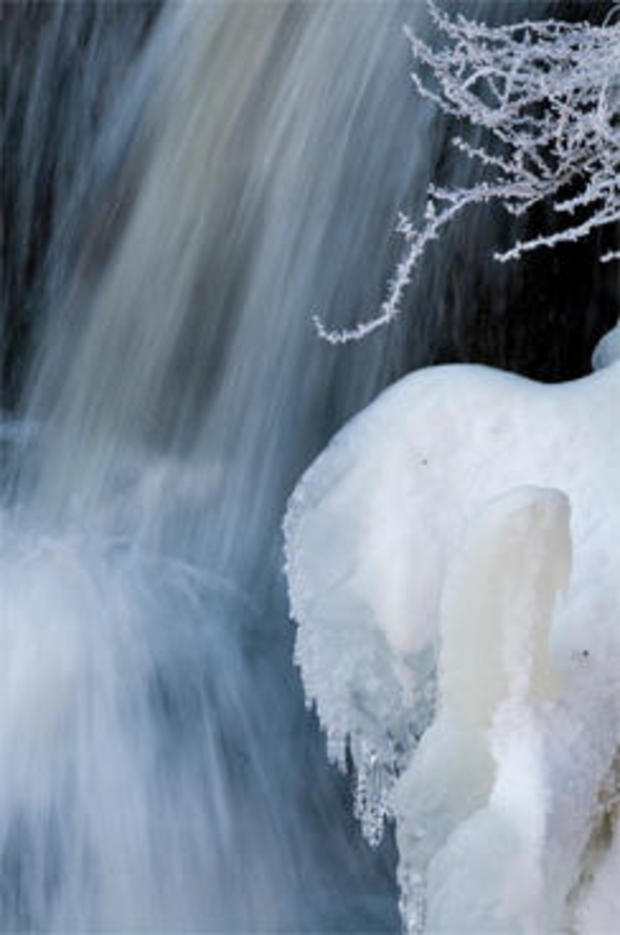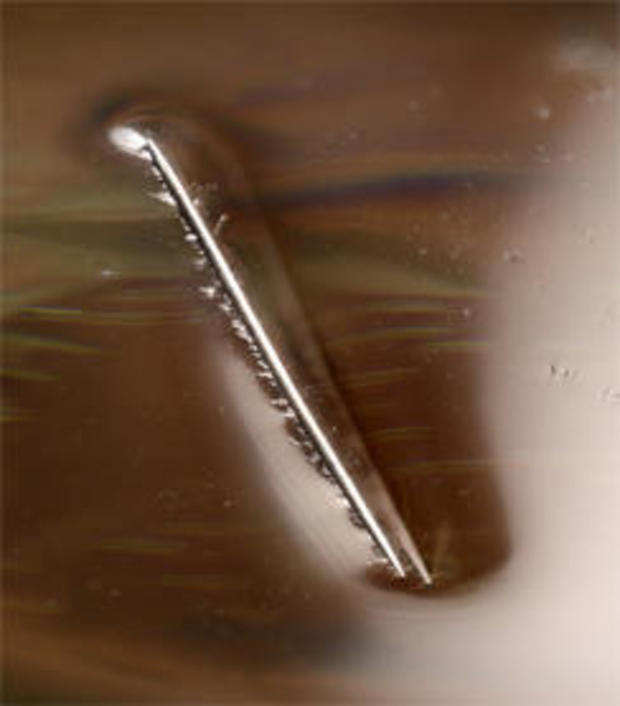Nature up close: Water molecules
By “Sunday Morning” contributing videographer Judy Lehmberg.
“Sunday Morning”’s recent winter scene of snow and running brooks partially covered with ice, filmed near Craley, Pennsylvania, got me thinking about water.
We all know water is essential for all living organisms, but it is also a truly unique molecule which most of us take for granted. We know boats and lily pads float on it; we know it freezes when it gets cold enough; it has great cooling abilities; and it is a good solvent. We know it is the substance for which space probes look on other planets as they prospect for alien life, because -- so far -- no organism has been found on Earth that can exist without liquid water. This is true even in Antarctic glaciers, as deep ice cores have shown water and microbes existing between ice crystals. Other planets may harbor life, because water has been found many places in our solar system, including Jupiter’s moon Europa, which may have more water than the planet Earth.
From a chemical standpoint, water has unusual properties that make it intricately associated with life. It consists of hydrogen and oxygen atoms bound together, with a chemical formula of H2O. What is less commonly known is that there is a bond between oxygen and each of the two hydrogens consisting of a shared pair of electrons for each bond. The angle between the bonds is about 105 degrees, which is important as it results in some of water’s amazing properties.
Each water molecule is not linear, but bent, because oxygen has a greater share in those electrons. This bent molecule is richer in electron density around the oxygen atom, and poorer in electron density around the hydrogens, creating a molecule that is partially-negatively charged around the oxygen end and partially-positively charged around the hydrogens -- a polar molecule.
Many of the properties of this polar molecule are due to this uneven charge. The positive pole (hydrogen ends) attracts the negative pole of another molecule and so on and so on, producing water molecules that are linked through space by electrostatic attraction known as hydrogen bonding. This causes this very light molecule to be liquid between 0°C and 100°C. When it is in a liquid state the water molecules are always moving; the hotter the water, the more they are moving. As water is cooled, the molecules slow down. As they slow down, more and more of them form hydrogen bonds with other water molecules. Because each water molecule has its hydrogen atoms about 105 degrees apart, and because these hydrogen atoms are attracted to the oxygen of other water molecules, a crystal begins to form. The water molecules within the crystal are attracted to other water molecules, but only at very precise angles. They are basically holding each other at arm’s length so the water molecules are further apart in frozen water (ice). Because water molecules are more spread out when water is completely frozen, ice is less dense than liquid, and consequently lakes and ponds freeze from the top down rather than the bottom up (because less-dense ice floats on more-dense liquid water). That may not sound like a big deal if you are thinking about ice cubes in your glass of tea, but because the top ice insulates the water below, organisms below the ice can survive. (To fish that is a very big deal.)
Water is also a solvent. Many compounds, like salt (sodium chloride), easily dissolve in it because the partially-negative oxygen end of a water molecule can attract the positive sodium ion, and the partially-positive end of another water molecule can attract the negative chloride ion, separating -- and thus dissolving -- the salt. For this reason, living creatures -- from deer to maple trees -- carry water solutions of salts and nutrients within their bodies, transporting essential materials around to all of its cells.
One of the many physical properties of water due to hydrogen bonding is surface tension. Visualize water molecules within a glass of water: the molecules below the surface are completely surrounded and attached to a maximum number of water molecules. But the molecules at the surface can only be attracted to the water molecules beside and below it.
Because the surface water molecules are only attracted to about half the number of molecules as are the molecules deeper in the water, there is a greater attraction per molecule, forming a stronger bond. Imagine the surface molecules are all holding hands with each other, which allows surface tension to result. Insects, leaves and even a steel needle can float on this film.
Surface tension, and the resulting capillary action, is essential for plants to pull water from the ground and circulate nutrients (even to the highest parts of a tree). Think about how water is “pulled up” when a paper towel touches some spilled water and you get the idea.
Surface tension causes water droplets to assume a spherical shape in fog or small raindrops, and on surfaces where the cohesive forces in the water molecules are much greater than the adhesive forces between the surface and the water.
Dew forms spherical drops on desert beetles including ones in the genus Stenocara. These beetles evolved a surface that allows dew to form on their bodies as they point their abdomens up into the air, and then the water droplets run down to their mouths. This dew harvesting is necessary because in the Namibian desert where they live the rainfall is only a few millimeters a year at most, if it rains there at all.
Ice in the form of snow has many shapes depending upon the temperature at which it forms. It often forms six pointed stars – snowflakes -- with more than 80 distinct shapes possible. However it forms, snow gently falling and clinging to the conifers and on bare tree branches creates a scene of immense beauty in the Pennsylvania woods. It is also a great insulator, as it protects hibernating animals and dormant plant roots.
The shape of big snowflakes, drifting down into the hand of a child, creates wonderment, as it always has in all cultures. The Chinese kanji character for snow is “type of rain falling from a cloud which can be held in the hand.”
Judy Lehmberg is a former college biology teacher who now shoots nature videos.
For more info:
- Judy Lehmberg (Official site)
- Judy Lehmberg’s YouTube Channel
To watch extended “Sunday Morning” Nature videos click here!








